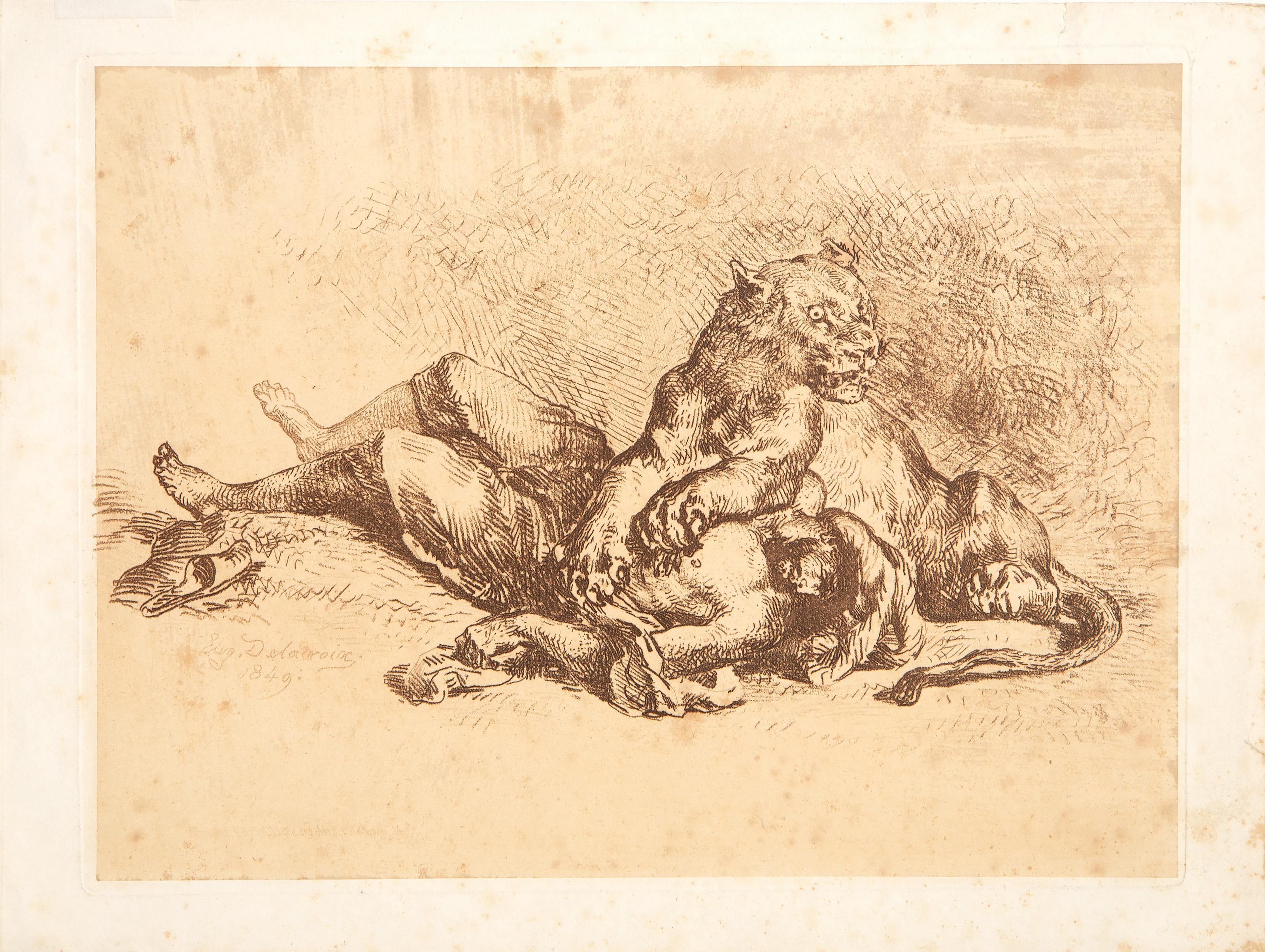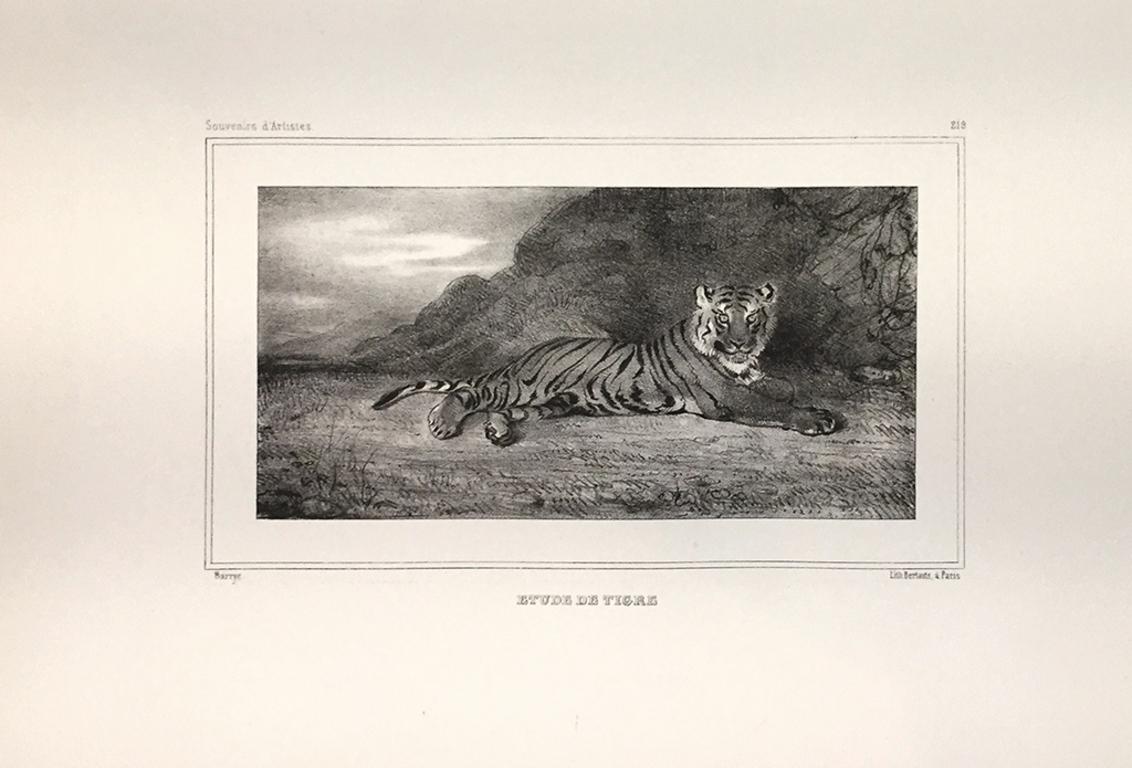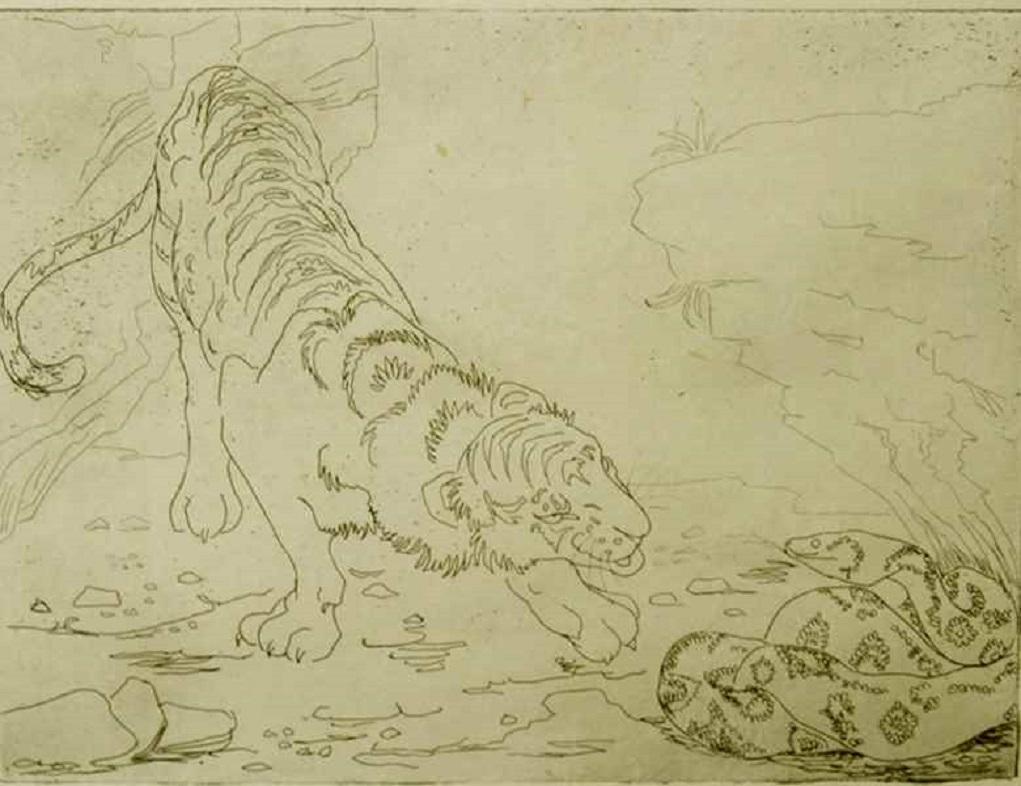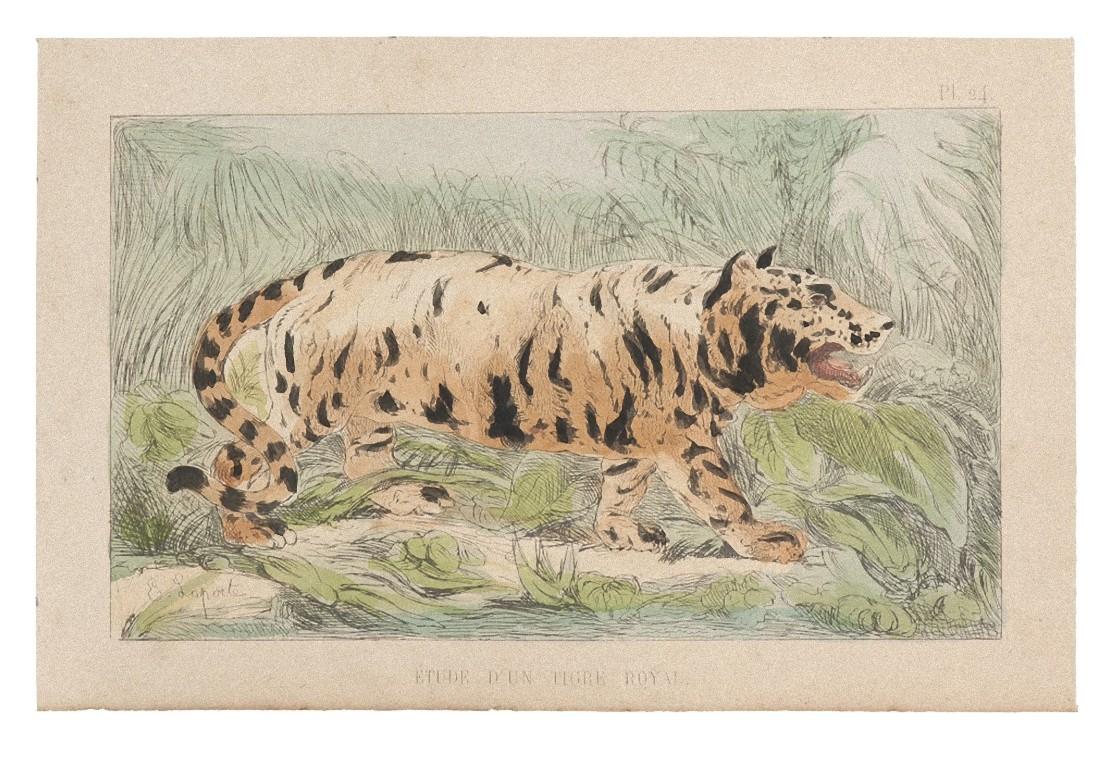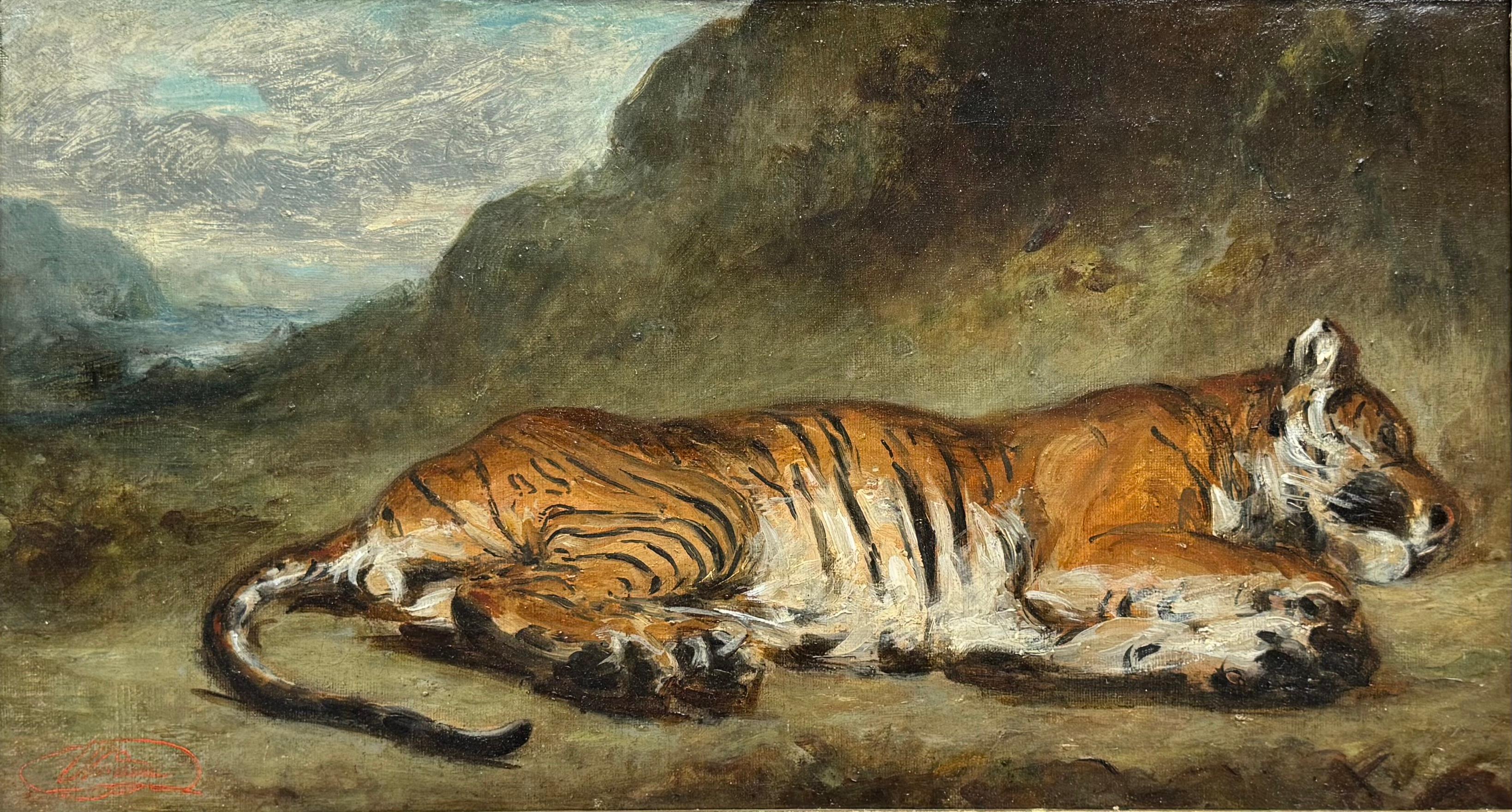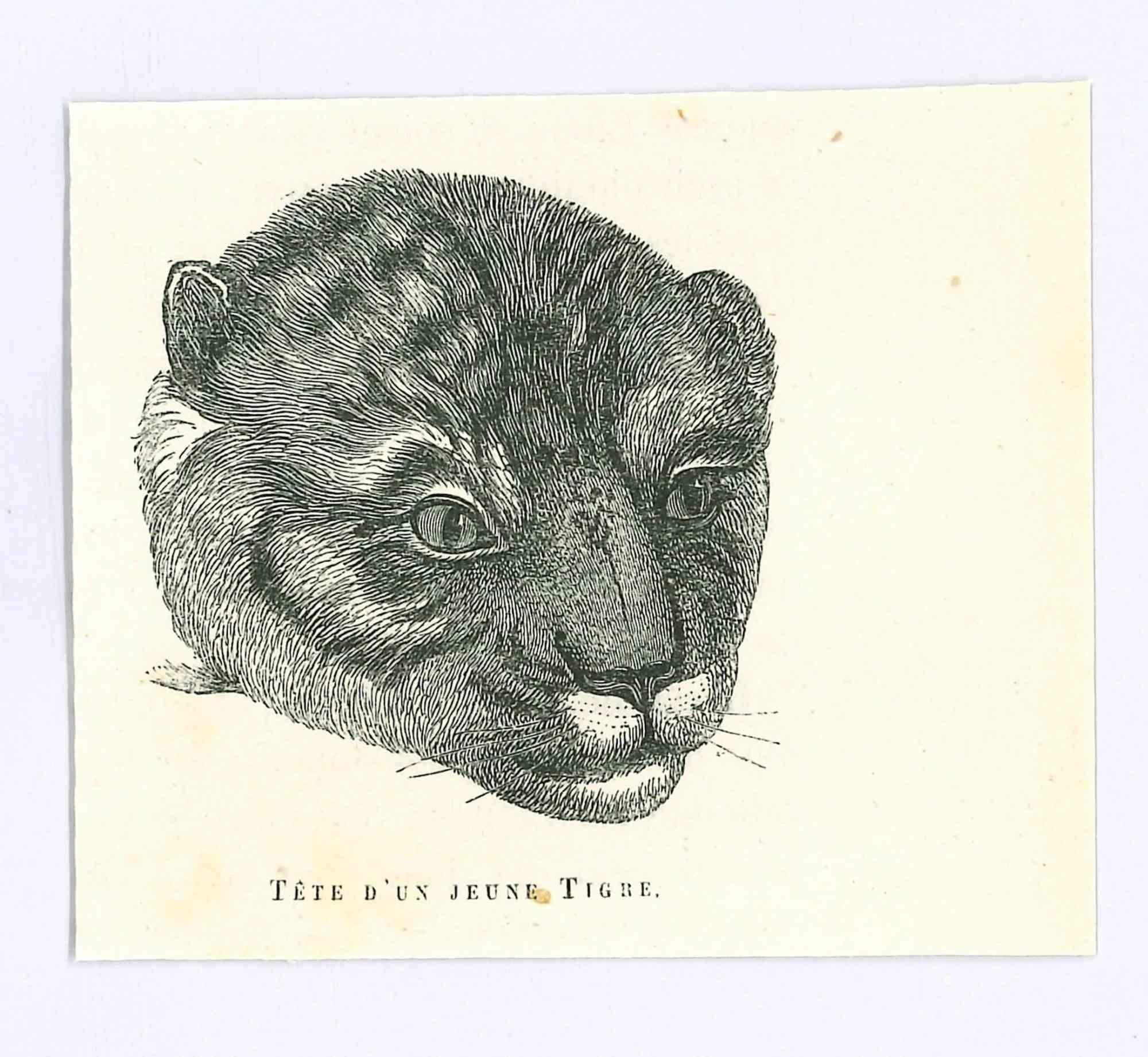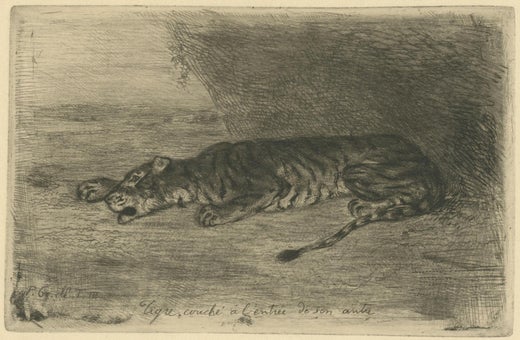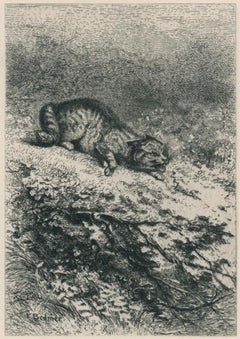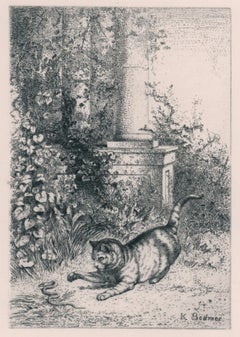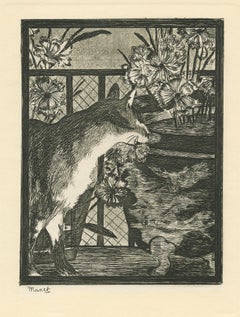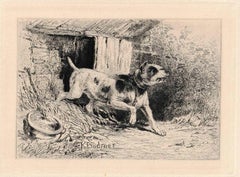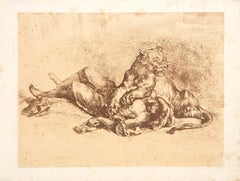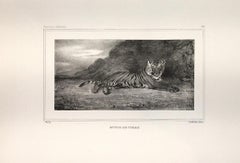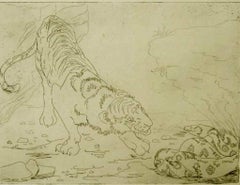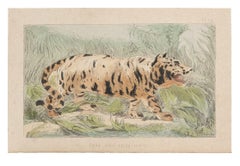Items Similar to Tigre couché à l'entrée de son antre (Tiger Lying at the Entrance to its Lair)
Want more images or videos?
Request additional images or videos from the seller
1 of 2
Eugène DelacroixTigre couché à l'entrée de son antre (Tiger Lying at the Entrance to its Lair)circa 1830
circa 1830
$600
£452.80
€518.39
CA$846.20
A$929.02
CHF 484.67
MX$11,242.45
NOK 6,074.61
SEK 5,723.88
DKK 3,869.65
About the Item
Etching, drypoint, and roulette on watermarked Hallines cream laid paper, 3 3/4 x 5 7/8 inches (95 x 148 mm), full margins. A very good impression of this charming image, with all of the fine lines printing clearly. Plate is inky and well-wiped. Scattered light surface soiling, age tone, and mat tone. Several scattered spots of foxing, all outside of image area. Issued 1908, as the frontispiece in Le Peintre-Graveur Illustre (third volume: Ingres and Delacriox). Sixth state (of 6).
[Delteil 12].
- Creator:Eugène Delacroix (1798-1863, French)
- Creation Year:circa 1830
- Dimensions:Height: 3.75 in (9.53 cm)Width: 5.875 in (14.93 cm)
- Medium:
- Movement & Style:
- Period:
- Condition:
- Gallery Location:Middletown, NY
- Reference Number:Seller: BH1301stDibs: LU1979210364322
Eugène Delacroix
Ferdinand Victor Eugène Delacroix (French: 26 April 1798 – 13 August 1863) was a French Romantic artist regarded from the outset of his career as the leader of the French Romantic school. In contrast to the Neoclassical perfectionism of his chief rival Ingres, Delacroix took for his inspiration the art of Rubens and painters of the Venetian Renaissance, with an attendant emphasis on colour and movement rather than clarity of outline and carefully modelled form. Dramatic and romantic content characterized the central themes of his maturity, and led him not to the classical models of Greek and Roman art, but to travel in North Africa, in search of the exotic. Friend and spiritual heir to Théodore Géricault, Delacroix was also inspired by Lord Byron, with whom he shared a strong identification with the "forces of the sublime", of nature in often violent action. However, Delacroix was given to neither sentimentality nor bombast, and his Romanticism was that of an individualist. In the words of Baudelaire, "Delacroix was passionately in love with passion, but coldly determined to express passion as clearly as possible."Together with Ingres, Delacroix is considered one of the last old Masters of painting and is one of the few who was ever photographed. As a painter and muralist, Delacroix's use of expressive brushstrokes and his study of the optical effects of colour profoundly shaped the work of the Impressionists, while his passion for the exotic inspired the artists of the Symbolist movement. A fine lithographer, Delacroix illustrated various works of William Shakespeare, the Scottish author Walter Scott, and the German author Johann Wolfgang von Goethe.
About the Seller
5.0
Vetted Professional Seller
Every seller passes strict standards for authenticity and reliability
Established in 2004
1stDibs seller since 2022
73 sales on 1stDibs
Typical response time: 7 hours
- ShippingRetrieving quote...Shipping from: Middletown, NY
- Return Policy
Authenticity Guarantee
In the unlikely event there’s an issue with an item’s authenticity, contact us within 1 year for a full refund. DetailsMoney-Back Guarantee
If your item is not as described, is damaged in transit, or does not arrive, contact us within 7 days for a full refund. Details24-Hour Cancellation
You have a 24-hour grace period in which to reconsider your purchase, with no questions asked.Vetted Professional Sellers
Our world-class sellers must adhere to strict standards for service and quality, maintaining the integrity of our listings.Price-Match Guarantee
If you find that a seller listed the same item for a lower price elsewhere, we’ll match it.Trusted Global Delivery
Our best-in-class carrier network provides specialized shipping options worldwide, including custom delivery.More From This Seller
View AllThe Wild Cat (Chat Sauvage)
By Karl Bodmer
Located in Middletown, NY
Etching on cream laid paper, full margins. From Eaux-Fortes Animaux & Paysages. [Beraldi II.140.34] Henri Béraldi Les graveurs du XIXe siècle: Guide de l'amateur d'estampes modernes. Librairie L. Conquet, vol. XII, Paris, 1885–1892, cat. no. 34, p. 140.
__________
Well known in his native Germany as a watercolorist, Karl Bodmer had a rich experience exploring in North America in the 19th century, accompanying German explorer Prince Maximilian zu Wied-Neuwied as the official artist on an expedition which toured the Missouri River...
Category
Mid-19th Century Barbizon School Animal Prints
Materials
Laid Paper, Etching
A Domestic Cat Playing with a Garter Snake, from Eaux-Fortes Animaux & Paysages
By Karl Bodmer
Located in Middletown, NY
Etching on cream laid paper, 6 1/8 x 4 3/4 inches (156 x 120 mm), full margins. In good condition with some minor, uniform age tone. Printed by George Bertauts, Paris.
[Beraldi II.140.26]
Henri Béraldi Les graveurs du XIXe siècle: Guide de l'amateur d'estampes modernes. Librairie L. Conquet, vol. XII, Paris, 1885–1892, cat. no. 34, p. 140.
__________
Well known in his native Germany as a watercolorist, Karl Bodmer had a rich experience exploring in North America in the 19th century, accompanying German explorer Prince Maximilian zu Wied-Neuwied as the official artist on an expedition which toured the Missouri River...
Category
Mid-19th Century Barbizon School Animal Prints
Materials
Laid Paper, Etching
Le Chat et Les Fleurs
By Édouard Manet
Located in Middletown, NY
Etching and aquatint on cream laid, watermarked Rives paper. 6 5/8 x 5 inches (167 x 126 mm). Sixth and final state, a posthumous impression. A fine, inky impression with full margin...
Category
1860s Realist Figurative Prints
Materials
Aquatint, Etching
Watchdog, from Eaux-Fortes Animaux & Paysages
By Karl Bodmer
Located in Middletown, NY
Paris: Jules Géruzet, 1860. Etching on cream laid paper, 3 1/2 x 5 inches (88 x 121 mm), full margins. Minor uniform age tone. Printed by George Bertauts, Paris.
[Beraldi II.140.24...
Category
Mid-19th Century French School Animal Prints
Materials
Laid Paper, Etching
Reapers at Rest
By Charles-Emile Jacque
Located in Middletown, NY
Etching on light gray Chine collant, laid down to ivory wove paper, 4 3/8 x 7 3/4 inches (110 x 195 mm) (Chine matrix), full margins. In very good condition with light mat tone and o...
Category
Mid-19th Century French School Figurative Prints
Materials
Handmade Paper, Etching
Faust, Méphistophélès et le Barbet / Faust, Méphistophélès and the Water Spaniel
By Eugène Delacroix
Located in Middletown, NY
Lithograph on Chine appliqué, 9 1/4 x 8 1/8 inches (235 x 206 mm), full margins. First state (of 4). Extremely minor uniform age tone, otherwise in good condition. A superb, richly-inked impression.
[Delteil 61.1]
______
At an early age Delacroix became a lover of music and literature and had been drawing from the time he entered school. He expected painting would be a hobby, but on the death of his father he found he had to make his own way in life. In 1817 he entered the studio of Pierre-Narcisse Guerin; amongst his fellow pupils was Gericault. His first exhibited work was Dante and Virgil...
Category
Early 19th Century Barbizon School Figurative Prints
Materials
Lithograph, Handmade Paper
You May Also Like
Lionne Dechirant la Poitrine d'un Arabe, Modern Etching by Eugene Delacroix
By Eugène Delacroix
Located in Long Island City, NY
Eugene Delacroix, French (1798 - 1863) - Lionne Dechirant la Poitrine d'un Arabe, Year: 1849, Medium: Soft Ground Etching, signed and dated in the plate, Image Size: 8 x 10.75 inch...
Category
1840s Old Masters Prints and Multiples
Materials
Etching
Etude de Tigre - Lithograph by Antoine-Louis Barye - Early 19th century
By Antoine-Louis Barye
Located in Roma, IT
Fine print with sheet in perfect conditions, on vélin blanc fort, belonging to the Bertauts Edition.
Perfect and vivid impression. Full margins.
Ref. Delteil 2.
Prov. Collection Hen...
Category
Early 19th Century Modern Figurative Prints
Materials
Lithograph
Tiger and Python by Orovida Pissarro, 1917 - Etching Print
By Orovida Pissarro
Located in London, GB
SOLD UNFRAMED
Tiger and Python by Orovida Pissarro (1893 - 1968)
Etching
22.5 x 27 cm (8 ⅞ x 10 ⅝ inches)
Signed, inscribed with title and dated 1917
State 1, no. 9/10
Provenance...
Category
1910s Animal Prints
Materials
Etching
The Tiger - Original Lithograph by Emile Henri Laporte - 1860
By Emile Henri Laporte
Located in Roma, IT
The Tiger is an original modern artwork realized in 1860 by the French artist Emile Henri Laporte (1841 - 1919).
Original colored Lithograph on paper. Han...
Category
1970s Modern Figurative Prints
Materials
Lithograph
Lying tiger
By Pierre Andrieu
Located in PARIS, FR
Oil on canvas
25 x 45,5 cm (34,7 x 55,2 cm with frame)
= 9.8 × 17.9 in (13.7 × 21.7 in with frame)
Signed lower left
Stamp of sale on the back of the canvas
In 1838, Eugène Delacro...
Category
19th Century Romantic Animal Paintings
Materials
Canvas, Oil
Tigre - Lithograph by Paul Gervais - 1854
By Paul Gervais
Located in Roma, IT
Tigre is an original lithograph on ivory-colored paper, realized by Paul Gervais (1816-1879). The artwork is from The Series of "Les Trois Règnes de la Na...
Category
1850s Modern Animal Prints
Materials
Lithograph, Paper
